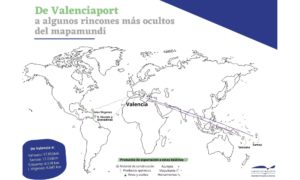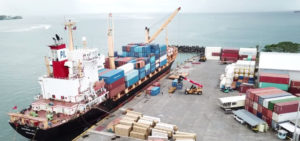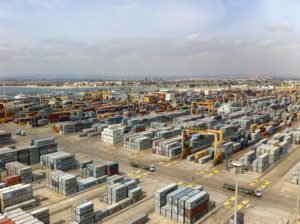
From Valencia, hundreds of thousands of containers are exchanged every year with China and the United States, but from the Port of Valencia you can also reach countries hidden in the world map to which only one or two containers are exported every year
Anguilla, Samoa, Vanuatu, Guam or the Solomon Islands are some of the most remote destinations where containers from Valenciaport also arrive
Construction material, tiles, machinery, chemical products, tools, wines and oils are Spanish export products that also reach the South Pacific islands, thanks to the efforts of the Port Community of Valencia
The Port of Valencia also connects with the remote islands of the South Pacific and the Indian Ocean, even if it is only to carry one container a year. It is the maximum expression of Valenciaport’s capillarity. Thousands of containers a day are exchanged with China, the United States, Italy, Turkey or Brazil; but from the Port of Valencia, they also attend to requests for imports and exports from countries that are remote islands hidden in the eternity of the waters of the Indian Ocean, the Caribbean and the South Pacific.
Anguilla, Papua New Guinea, Vanuatu, Wallis and Futuna, Virgin Islands, Guam, etc. These are countries, independent states, of which we did not know, in some cases, even their names and that requires patience to find them in the world map. To those countries, with those ports that can attend the unloading of containers thanks to the fact that the ships that dock in the smaller ports take their own cranes, also it is connected from Valencia.
A single container a year for these exclusive destinations
Statistics from the Port Authority of Valencia (APV) show that in 2019 one container – only one – was exported to Anguilla, another to Samoa and another to Vanuatu. These three countries/islands of the Caribbean and the Pacific are an emblem for the Port of Valencia and for the transport companies that manage the transfer and contracting of goods destined to such remote enclaves.
Anguilla is 6,400 km from Valencia. It is a British overseas territory in the process of decolonization by the United Nations. It has 14,700 inhabitants and an area of 212 km2. An extension equivalent to that of the municipality of the city of Alicante (200 km2) or of Llíria (228 km2). Every year a container – only one – loaded with different goods arrives at its main port in the Port of Valencia.
The other two countries that also receive a single container from Valencia are 17,000 km away. They are Samoa and Vanuatu. Samoa (197.000 inhabitants) is located in the South Pacific; at the antipodes of the Valencian docks, “halfway between Hawaii and New Zealand”. Vanuatu (293.000 inhabitants) is a neighbouring country of Samoa, in the same ocean. For Samoa and Vanuatu was loaded last year a container (one for each country) of construction material (in both cases).

Countries with less than 10 containers
Following in the ranking, and in ascending order, these three single-container countries are followed (with annual commercial traffic of two containers/year) by Wallis and Futuna. This is a French overseas collectivity formed by three tropical islands of volcanic origin that are located in the South Pacific, between Fiji and Samoa, and with a population of 15,000 inhabitants. Two containers with machinery and spare materials arrived there in 2019, leaving from the Port of Valencia… 17,196 kilometres away.
Valenciaport also puts its flag annually in Papua New Guinea, Guam, St. Vincent and the Grenadines. Papua is a region in the southwest Pacific that covers the eastern half of New Guinea and its islands, and which is surrounded by the seas of Bismarck, Solomon, Arafura and Coral. Close to Australia and neighbouring to the Solomon Islands, Vanuatu, Wallis and Futuna or Fiji, three containers with machinery and tools were unloaded in the ports of Papua last year. Also in Guam, a key island for its importance during the Second World War located in the immensity of the South Pacific, belonging to the United States, and with a past with the Spanish colonial period, a container of oil and two of wines from Valencia were unloaded. Saint Vincent and the Grenadines, a leafy island in the Caribbean Sea with underwater volcanic mountains, black sand beaches and forests with native birds received two containers of machinery and one of the chemicals.
Valenciaport’s global reach brings connectivity to Spanish exporters and importers, who can be present in any corner of the Pacific or the Indian Ocean. This is the case with the four containers of frozen fish that arrive in the Solomon Islands or East Timor where five containers full of wines and beverages from Spain arrive each year. The Kingdom of Tonga is a country in Oceania integrated into Polynesia, located 2,382 kilometres from New Zealand that last year received in its port six containers from Valencia loaded with machinery and construction materials. Closing the top of territories with less than 10 containers we find the Fiji Islands, an archipelago composed of more than 300 islands and famous for its rugged landscapes, palm-lined beaches and coral reefs with crystalline water lagoons. A paradise that received eight containers managed from Valenciaport with preserves, drinks or chemical products “made in Spain”.
Valenciaport’s connectivity reaches 1,000 ports around the world
More than 5 million containers pass through the terminals of Valenciaport every year, with origin and destination to 1,000 ports in two hundred countries and with the most varied goods. The United States Virgin Islands, located in the Caribbean, received in 2019 13 containers with machinery and 2 with steel products. Taking a quantitative leap are St. Kitts and Nevis, or what is the same, the Islands of St. Christopher and Nevis, also located in the Caribbean and which owe their name to the discoverer of America, Christopher Columbus and the snow on his summit (actually caused by the clouds). This territory is the smallest country on the American continent, both in size and population with an area of 261 km2 (twice the size of the municipality of Valencia) and 55,000 inhabitants and to whose port arrive 25 containers with construction materials or machinery, among others, from Valencia.
The connectivity and capillarity of Valenciaport is and has been throughout history a differential element of the Valencian port. There are no limits: from the 838,398 containers exchanged with the more than 80 ports in China with which Valenciaport works, to the only container that is laboriously made to arrive in Anguilla, Samoa or Vanuatu; and be careful; because at any time a freight company could receive an order from an exporter from Ontinyent, Toledo, Cáceres or Nules, to make a container arrive in the most hidden corner of the world map… and it would arrive.


